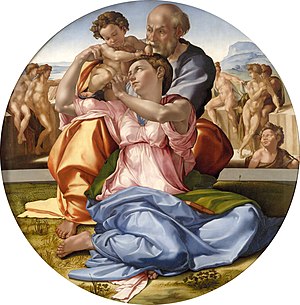Tondo Doni

|
| Tondo Doni |
| Michelangelo Buonarroti , 1506–1508 |
| Oil and tempera on wood, ∅ 120 cm |
|
Florence , Galleria degli Uffizi
(Inv.-No .: 1890, after 1456, acquired before 1653) |
The Holy Family , called Tondo Doni ("Doni-Rundbild"), is one of the most famous paintings by Michelangelo Buonarroti and the Italian Renaissance .
The nickname comes from the first owner of the picture, Agnolo Doni . It is still in its original frame and is the only completely undisputed panel painting by the artist. In the middle distance, on the wall that separates the group of figures in the foreground from that in the background, stands another boy who can be identified as John the Baptist because of the camel skin that is slung over his head .
interpretation
Until the 17th century, the work was only considered a devotional picture, which shows how Joseph hands the Christ child to Mary, who has just finished reading. Only then did they try to see an allegory in the picture. The main group should stand in the foreground for the Catholic Church, while the nudes in the background, which are interpreted by some as fauns, represent symbols of classical antiquity. Other researchers see in the figures in the background an allegory of the ages and thus an allusion to the transience of life. You also try to recognize different symbols in the picture. The nudes in the background, humanity ante Legem , Mary and Joseph humanity sub Lege and the Christ child are supposed to represent humanity sub Gratia . It has also been assumed that Michelangelo depicted the name Agnolo Donis, for whom he painted the board, in the picture in encrypted form, when Maria asked Joseph to give her the child ( donare in Italian ).
Chronological order
The time of its creation is just as controversial. Vasari wrote in 1550 that the picture in front of Bacchus , it is in the Museo Nazionale del Bargello in Florence, was created. In the edition of 1568 he revised this view and advocated a later date of origin. Around 1893 Grimm dated it to the year 1503. In 1907 Giovanni Poggi put forward the thesis that the presence of the Strozzi coat of arms on the frame was a sure sign that the picture was painted as a wedding present for Antonio Doni with Maddalena Strozzi. The celebrations lasted from the end of 1503 to the beginning of 1504. Fritz Baumgart (1934/1935), on the other hand, suggested that the picture should be made later, parallel to the Sistine ceiling. The also voted Sandro Botari (1941) to. Charles de Tolnay (1946 to 1953), on the other hand, took the view that an emergence near the cardboard box for the battle of Càscina was more likely. In the following years, however, the Poggis thesis prevailed among most researchers. A thorough restoration of the work took place in 1985, which caused a few surprises. The previously pale colors now shone with an intensity that refuted the long-held opinion that Michelangelo was not necessarily a good colorist. At the same time, the date most frequently used up to now had to be corrected. A direct dependency of the figure poses on the famous Laocoon group , which was only discovered in January 1506, now appears more clearly than before , so that the time between this point and the beginning of work on the Sistine ceiling seems most likely.
literature
- Charles de Tolnay and Ettore Camesaca: Classics of Art - The painted work of Michelangelo , Kunstkreis Luzern - Freudenstadt - Vienna, 1966
- Caterina Caneca, Alessandro Cecchi and Antonio Natali: The Uffizi Gallery , Florence 1986